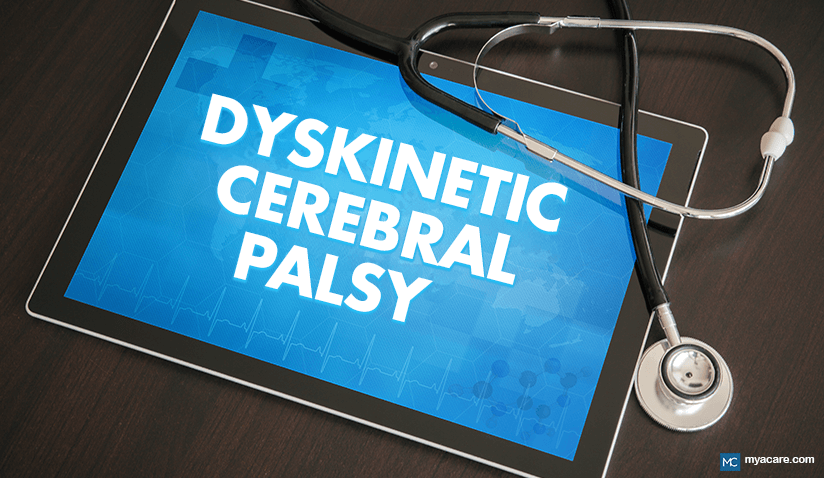What Is Dyskinetic Cerebral Palsy? A Comprehensive Overview

Medically Reviewed by Dr. Sony Sherpa, (MBBS)
What is Dyskinetic Cerebral Palsy?
Management and Treatment Options
Cerebral palsy (CP) is a neurological movement disorder that affects motor skills and muscle coordination, resulting from damage to the brain during its development. Dyskinetic cerebral palsy (DCP) is a subtype of cerebral palsy defined by movement disorders stemming from damage to the basal ganglia, the brain's movement and coordination center. Though DCP does not progress over time, it is non-reversible, meaning it can be managed but not cured.
Within the broader spectrum of cerebral palsy, DCP makes up a significant portion of cases, with research indicating it occurs in approximately 10-15% of people diagnosed with CP. Its prevalence, while not the most common subtype, underscores the unique challenges it presents for both people and caregivers. This article provides a comprehensive overview of DCP, detailing its causes, symptoms, diagnostic approaches, and treatment options.
Symptoms
The hallmark symptoms of dyskinetic cerebral palsy include involuntary movements, fluctuating muscle tone, and difficulties with posture and coordination. These can manifest as slow, writhing movements (known as athetosis), repetitive twisting movements (dystonia), or a combination of jerky and smooth motions (choreoathetoid).
Involuntary movements can vary greatly in severity, affecting a person’s ability to walk, speak, and perform daily tasks. Muscle tone may shift between stiffness (hypertonia) and floppiness (hypotonia), further complicating motor control. This makes tasks such as holding objects or sitting upright challenging for people with DCP.
Types of Dyskinetic Cerebral Palsy
Based on the nature of involuntary movements, dyskinetic cerebral palsy is classified into three distinct subtypes. These include athetoid cerebral palsy, dystonic cerebral palsy, and choreoathetoid cerebral palsy. Each type presents a unique set of challenges and movement patterns that require tailored management and treatment strategies.
Athetoid Cerebral Palsy
The hallmark of athetoid cerebral palsy is slow, writhing, and twisting movements, prominently seen in the hands, feet, arms, and legs. These involuntary movements can be highly variable, making it difficult for people to control their limbs. The movements tend to worsen during times of stress or fatigue and are less noticeable during periods of calm. The condition can make tasks like walking, feeding oneself, or writing very challenging, but with the appropriate therapy and interventions, many people can improve their functional abilities.
Dystonic Cerebral Palsy
Dystonic cerebral palsy involves sustained muscle contractions that cause twisting, repetitive movements, or abnormal postures. This type often results in painful and uncomfortable positions where muscles may remain contracted for long periods. Unlike the jerky movements seen in other forms of CP, dystonic movements tend to be more continuous and can affect a person’s ability to maintain a stable posture. The discomfort caused by these contractions can lead to secondary issues such as joint deformities or chronic pain.
Choreoathetoid Cerebral Palsy
Choreoathetoid cerebral palsy is a combination of chorea (rapid, jerky movements) and athetosis. This subtype of DCP presents both involuntary movements that are sudden and unpredictable, as well as slow, writhing motions. It is one of the more complex forms of DCP, as it requires managing both types of abnormal movement. The variability in movement patterns can cause challenges in coordination and make activities like speaking or feeding even more difficult.
Causes and Risk Factors
As mentioned above, damage to the basal ganglia, which is the brain structure controlling movement, typically causes dyskinetic cerebral palsy. This damage can occur during prenatal, perinatal, or postnatal stages of brain development.
Prenatal Causes
During pregnancy, damage to the developing brain can result from various factors such as maternal infections, exposure to toxins, or complications that affect oxygen supply. For instance, maternal health conditions, such as high blood pressure or diabetes, can elevate the risk of complications leading to cerebral palsy. Additionally, premature birth, which often leads to underdeveloped organs, can raise the risk of brain damage, including damage to the basal ganglia.
Perinatal and Postnatal Causes
Perinatal causes relate to factors that occur around the time of birth, such as birth asphyxia (lack of oxygen during delivery), infections, or traumatic injuries. Postnatal factors , although less common, include brain injuries that occur after birth, such as head trauma or infections affecting the brain.
While these factors can contribute to the development of DCP, some cases may arise without a clear cause, making it difficult to pinpoint exact risk factors in every case.
Diagnosis
Diagnosing DCP typically involves a clinical assessment by a pediatrician or neurologist. Observing the child’s movement patterns and developmental milestones is crucial. Neuroimaging studies, including MRI and CT scans, may be performed to assess brain structure and identify abnormalities in motor control regions, including the basal ganglia.
Early diagnosis enables appropriate treatment plans to be initiated, including physical therapy, medications, or surgical interventions, which are essential for managing symptoms and improving the child's overall well-being.
Dystonia vs. Dyskinesia: Clarifying the Terms
Although sometimes used synonymously, "dystonia" and "dyskinesia" describe separate movement disorders when discussing cerebral palsy.
Dystonia
Dystonia refers to involuntary muscle contractions that produce repetitive, twisting movements or sustained abnormal postures. It can be painful and may interfere with coordination, affecting the hands, legs, and other parts of the body.
Dyskinesia
Dyskinesia, on the other hand, is a broader term that refers to involuntary movements, encompassing conditions like dystonia, athetosis, and chorea. Individuals with dyskinetic cerebral palsy experience varying forms of dyskinesia, each of which presents different challenges. Understanding these terms helps clinicians devise a more accurate treatment strategy tailored to each person’s specific needs.
Management and Treatment Options
Managing dyskinetic cerebral palsy involves a multidisciplinary approach. Treatment strategies aim to improve motor skills, reduce involuntary movements, and address associated complications like joint deformities or pain.
Physical and Occupational Therapy
Physical therapy plays a critical role in improving motor skills, posture, and overall mobility. Occupational therapy helps with performing everyday tasks such as eating, dressing, and writing. Both therapies aim to enhance functional independence and improve quality of life.
Medications
Medications such as muscle relaxants, antispasmodics , and botulinum toxin (Botox) injections are often used to help reduce muscle contractions and control spasticity or dystonia. These treatments can provide temporary relief from muscle tightness and improve the range of motion.
Surgical Interventions
In some cases, surgical interventions like deep brain stimulation (DBS) may be considered. By implanting electrodes that deliver electrical stimulation to targeted brain areas, deep brain stimulation aims to regulate and normalize abnormal movement patterns. While not a cure, DBS can help reduce symptoms. Other surgical procedures may involve tendon lengthening or selective dorsal rhizotomy to improve mobility and muscle tone.
Assistive Devices
Individuals with dyskinetic cerebral palsy may benefit from various assistive devices, such as mobility aids (wheelchairs, walkers), communication tools (speech-generating devices), and splints. These devices help facilitate daily activities and enhance independence.
Living with Dyskinetic Cerebral Palsy
Living with dyskinetic cerebral palsy presents unique challenges, especially when it comes to daily activities, education, and social interactions. Children with DCP may require accommodations in school, such as physical therapy sessions or specialized teaching methods. Social inclusion and emotional support are vital to help those with DCP build self-esteem and foster positive relationships.
Family, caregivers, and professionals working together as a support network are vital in improving an individual's quality of life. Community resources, such as therapy programs and support groups, also offer valuable assistance in managing the day-to-day realities of living with DCP.
Recent Research and Innovations
While dyskinetic cerebral palsy presents significant challenges, the quality of life for individuals with this condition can be significantly enhanced through timely diagnosis and a well-structured treatment strategy.
Advancements in therapeutic interventions, including targeted therapies and assistive technologies, continue to improve the lives of those affected. Clinical trials focusing on medications, surgical techniques, and neurostimulation are also underway to explore new ways to manage symptoms and enhance motor function.
Ongoing research holds promise for further innovations in the treatment of DCP, with the goal of offering greater independence, mobility, and quality of life. As the condition becomes better understood, more personalized and effective treatments will likely become available.
Frequently Asked Questions
Is Dyskinetic Cerebral Palsy Progressive?
No, dyskinetic cerebral palsy is not progressive. While the severity of symptoms may fluctuate, the condition does not worsen over time. Timely intervention and effective management strategies empower individuals to live fulfilling lives.
Is Cerebral Palsy Painful?
Many people with cerebral palsy experience discomfort due to muscle spasms, joint deformities, and abnormal postures. Pain management strategies, including physical therapy, medications, and assistive devices, can help alleviate pain and minimize discomfort.
What Are the Various Types of Cerebral Palsy?
Cerebral palsy is primarily classified into four main types: spastic, dyskinetic, ataxic, and mixed. Each type presents different challenges in terms of movement, coordination, and muscle tone.
Dystonia vs. Athetosis: What’s the Difference?
Dystonia involves sustained muscle contractions and abnormal postures, while athetosis refers to slow, writhing movements. Both are forms of dyskinetic movements but have distinct features that require different management approaches.
To search for the best Neurology healthcare providers in Azerbaijan, Germany, India, Malaysia, Spain, Thailand, Turkey, UAE, UK and the USA, please use the Mya Care search engine.
To search for the best Doctors and Healthcare Providers worldwide, please use the Mya Care search engine.
The Mya Care Editorial Team comprises medical doctors and qualified professionals with a background in healthcare, dedicated to delivering trustworthy, evidence-based health content.
Our team draws on authoritative sources, including systematic reviews published in top-tier medical journals, the latest academic and professional books by renowned experts, and official guidelines from authoritative global health organizations. This rigorous process ensures every article reflects current medical standards and is regularly updated to include the latest healthcare insights.

Dr. Sony Sherpa completed her MBBS at Guangzhou Medical University, China. She is a resident doctor, researcher, and medical writer who believes in the importance of accessible, quality healthcare for everyone. Her work in the healthcare field is focused on improving the well-being of individuals and communities, ensuring they receive the necessary care and support for a healthy and fulfilling life.
References:
Featured Blogs



